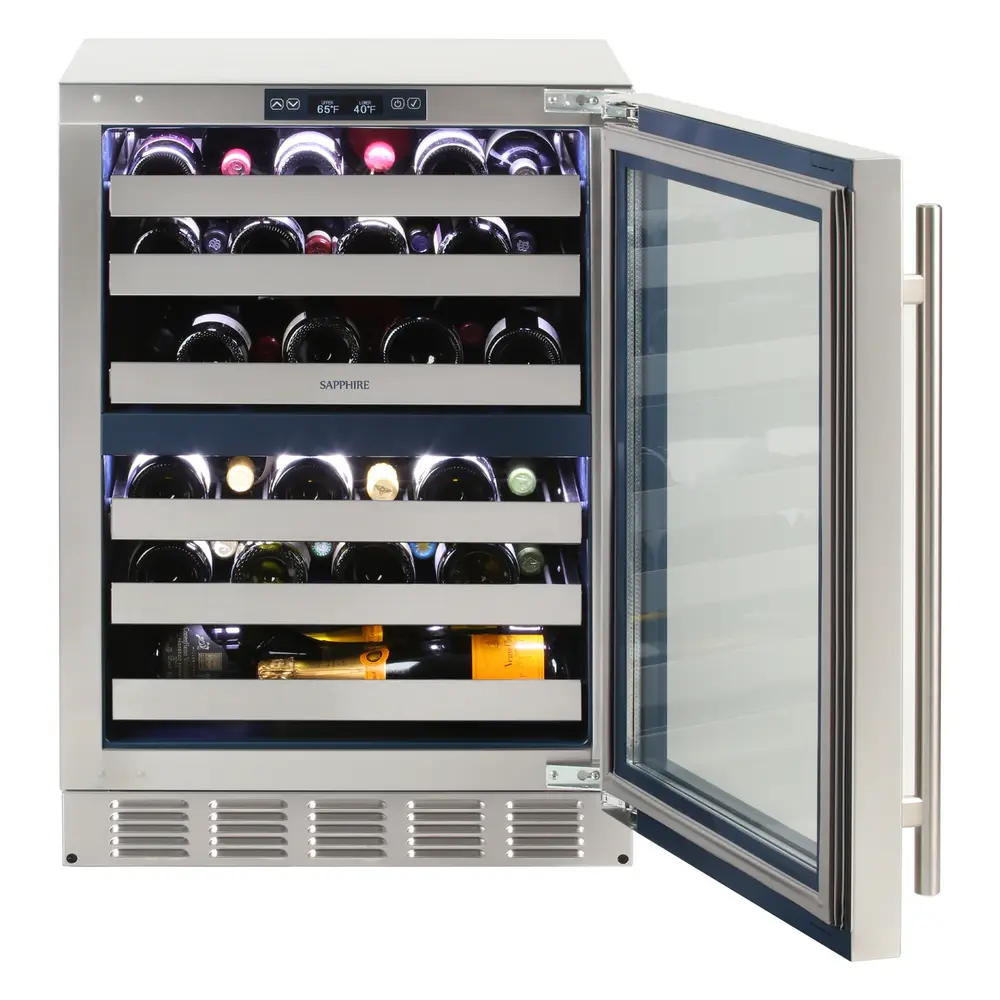Buying Guides Categories
Indoor v. Outdoor Wine Coolers and Beverage Centers
When deciding between indoor and outdoor wine coolers or beverage centers, it’s essential to understand the differences in their construction, design, and performance based on the intended use environment. Below is a detailed comparison to help you make the right choice for your space:

1. Construction and Durability
Indoor Wine Coolers & Beverage Centers
- Materials: Indoor units are typically made from lighter materials such as regular stainless steel, plastic, and glass, since they are designed for climate-controlled environments.
- Ventilation: Indoor coolers do not need to account for extreme temperature fluctuations or weather conditions. As a result, they are less robust and may require less insulation.
- Durability: Indoor units are perfect for areas like kitchens, dining rooms, and home bars but may not be suitable for outdoor conditions where moisture, temperature swings, or sunlight could degrade the materials.
Outdoor Wine Coolers & Beverage Centers
- Materials: Outdoor units are designed to withstand the elements, often constructed from high-grade stainless steel and equipped with weatherproof seals. They resist corrosion, rust, and UV rays.
- Ventilation: Outdoor coolers are built with stronger cooling systems to combat fluctuating temperatures, including heat from direct sunlight. This ensures that your beverages remain chilled, even in extreme weather conditions.
- Durability: Outdoor units are often more rugged and built to handle rain, wind, and temperature changes. They also typically feature better insulation to maintain stable internal temperatures.
2. Temperature Control
Indoor Models
- Consistent Environment: Since they are placed in climate-controlled spaces, indoor models maintain steady temperatures without the need for heavy-duty cooling systems.
- Cooling Systems: Indoor units often feature compressor-based or thermoelectric cooling systems, which are suitable for stable indoor environments. These systems are quieter and more energy-efficient for indoor use.
Outdoor Models
- Advanced Cooling: Outdoor beverage centers use heavy-duty compressors to regulate temperatures even in hot weather, keeping your beverages cold regardless of the outdoor conditions.
- Temperature Range: Outdoor models often feature wider temperature ranges, allowing them to cool beverages to optimal temperatures even during extreme heat or cold weather.
3. Insulation and Energy Efficiency
Indoor Models
- Standard Insulation: Indoor units have standard insulation designed to keep beverages cool in a controlled indoor environment. They are generally more energy-efficient because they don’t have to work as hard to maintain temperatures.
- Lower Energy Consumption: Since they don’t deal with temperature swings, indoor wine coolers and beverage centers are often less energy-intensive than outdoor models.
Outdoor Models
- Superior Insulation: Outdoor units are built with advanced insulation to protect against external temperature changes. This ensures that the internal temperature remains stable even if the outdoor temperature rises or falls.
- Higher Energy Usage: Due to the need to combat outdoor conditions, outdoor units tend to consume more energy. However, ENERGY STAR® rated outdoor models are available to improve efficiency.
4. Features and Convenience
Indoor Models
- Sleek Aesthetics: Indoor wine coolers and beverage centers focus more on aesthetics, often featuring modern glass doors, LED lighting, and stylish finishes that blend with kitchen or bar decor.
- Quiet Operation: Indoor units are designed to operate quietly, which is ideal for home use where minimal noise is preferred.
- UV Protection: Though not always necessary, some indoor units offer UV-protected glass doors for wine storage.
Outdoor Models
- Weatherproof Design: Outdoor units come with features like UV-protected glass doors, waterproofing, and rust-resistant materials to handle exposure to the elements.
- Temperature Flexibility: These units often have adjustable temperature zones and are built to handle quick temperature shifts.
- Noise Considerations: Outdoor units may produce more noise due to their heavy-duty compressors, but the sound is less noticeable in open spaces.
5. Placement and Installation
Indoor Models
- Placement Flexibility: Indoor units can be freestanding or built-in, placed in kitchens, dining rooms, or living spaces. They typically don’t require extensive installation beyond simple plug-in and setup.
- Less Ventilation Needs: Indoor coolers often need less clearance around them, making them easier to incorporate into built-in spaces.
Outdoor Models
- Installation Needs: Outdoor units, particularly built-in models, may require more careful installation to ensure proper ventilation and protection from the elements.
- Clearance for Ventilation: Outdoor units, especially freestanding ones, need space for ventilation to function properly, so it’s important to account for adequate airflow around the unit.
6. Price Differences
- Indoor Models: Generally, it is more affordable due to fewer design constraints and simpler cooling systems. They can range from budget-friendly to luxury models depending on features and capacity.
- Outdoor Models: Outdoor wine coolers and beverage centers are more expensive because of their weather-resistant materials, heavy-duty cooling systems, and added insulation.
7. Ideal Use Cases
Indoor Wine Coolers & Beverage Centers:
- Best For: Kitchens, dining rooms, home bars, living spaces, or game rooms where temperature is controlled.
- Usage: Indoor use for everyday home entertainment, family gatherings, or wine storage.
Outdoor Wine Coolers & Beverage Centers:
- Best For: Patios, outdoor kitchens, grilling stations, and poolside bars.
- Usage: Outdoor parties, barbecues, and entertainment, where durable and weather-resistant storage is required.
Conclusion
Choosing between an indoor and outdoor wine cooler or beverage center depends on where you plan to use the unit, the type of beverages you store, and how much you want to spend. Indoor models focus on aesthetics and quiet operation, while outdoor units are built for durability, extreme temperatures, and weather resistance.
Explore Homery.com for a wide selection of both indoor and outdoor wine coolers and beverage centers to suit your home’s needs!
